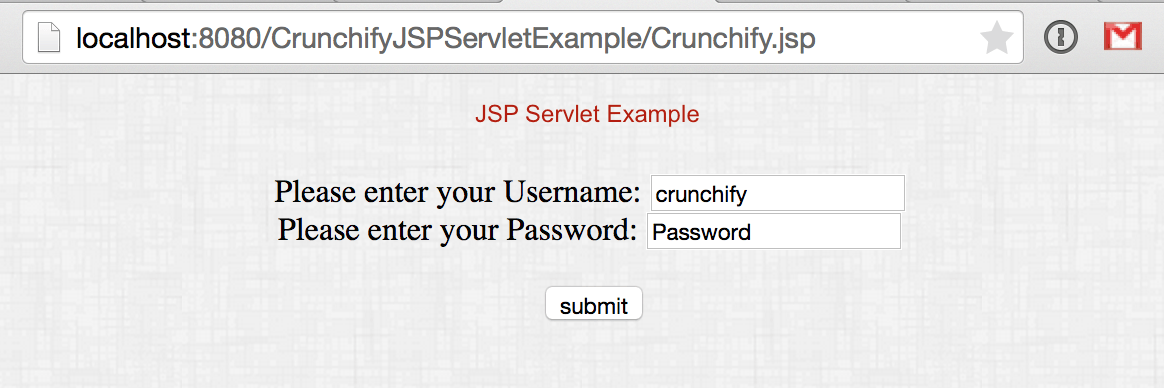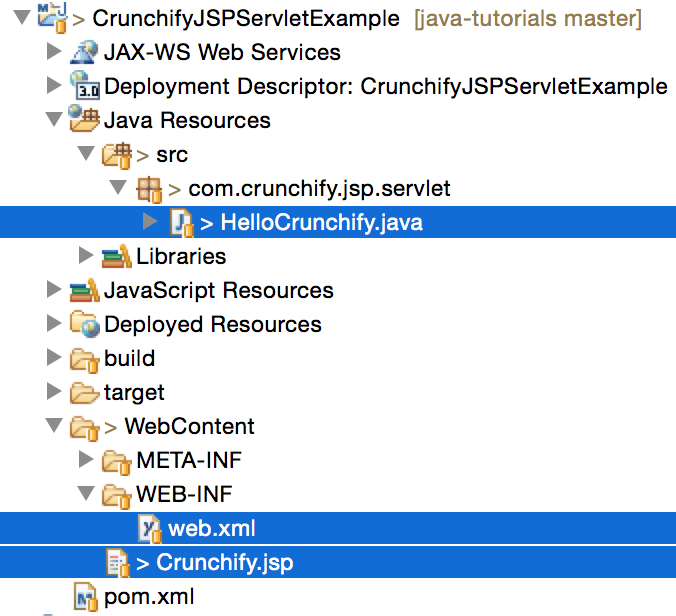Esercitazione sul servlet: Introduzione a JSP – Esempio di servlet
Pubblicato: 2013-07-16
Ecco un semplice esempio JSP – Servlet con istruzioni dettagliate. Dimostrerò come recuperare i parametri della richiesta in JSP – Esempio di servlet.
Ecco i passaggi che andremo ad eseguire:
- Apri Eclipse IDE.
- Crea un nuovo progetto Web dinamico CrunchifyJSPServletExample.
- Crea file HelloCrunchify.java estende HttpServlet (Elenco di tutti i 200 esempi Java).
- Crea il file Crunchify.jsp .
- file web.xml (file descrittore di distribuzione).
- Se non vedi il file web.xml, trova la soluzione qui.
- Aggiungi ed esegui progetto su Tomcat Web Server.
Ecco una struttura completa del progetto:

Passo 1
Crea il file HelloCrunchify.java
|
1 2 3 4 5 6 7 8 9 10 11 12 13 14 15 16 17 18 19 20 21 22 23 24 25 26 27 28 29 30 31 32 33 34 35 36 37 |
package com . crunchify . jsp . servlet ; import java . io . IOException ; import javax . servlet . ServletException ; import javax . servlet . http . HttpServlet ; import javax . servlet . http . HttpServletRequest ; import javax . servlet . http . HttpServletResponse ; import java . io . PrintWriter ; /** * @author Crunchify.com */ public class HelloCrunchify extends HttpServlet { protected void doGet ( HttpServletRequest request , HttpServletResponse response ) throws ServletException , IOException { // reading the user input String username = request . getParameter ( "username" ) ; String password = request . getParameter ( "password" ) ; PrintWriter out = response . getWriter ( ) ; out . println ( "<!DOCTYPE html PUBLIC \"-//W3C//DTD HTML 4.01 Transitional//EN\" +" + "http://www.w3.org/TR/html4/loose.dtd\">\n" + "<html> \n" + "<head> \n" + "<meta http-equiv=\"Content-Type\" content=\"text/html; " + "charset=ISO-8859-1\"> \n" + "<title> Crunchify.com JSP Servlet Example </title> \n" + "</head> \n" + "<body> <div align='center'> \n" + "<style= \"font-size=\"12px\" color='black'\"" + "\">" + "Username: " + username + " <br> " + "Password: " + password + "</font></body> \n" + "</html>" ) ; } } |
Un altro deve leggere:
- Come eseguire automaticamente il programma Java all'avvio di Tomcat
- Come utilizzare AJAX, jQuery in Spring Web MVC (.jsp) – Esempio
Passo 2
Crea il file Crunchify.jsp :
|
1 2 3 4 5 6 7 8 9 10 11 12 13 14 15 16 17 18 19 20 21 22 23 24 25 26 27 28 29 30 |
<% @ page language = "java" contentType = "text/html; charset=ISO-8859-1" pageEncoding = "ISO-8859-1" %> < ! DOCTYPE html PUBLIC "-//W3C//DTD HTML 4.01 Transitional//EN" "http://www.w3.org/TR/html4/loose.dtd" > < html > <style type ="text/css"> body { background-image : url ( 'https://cdn.crunchify.com/wp-content/uploads/2013/03/Crunchify.bg_.300.png' ) ; } </style> < head > < meta http - equiv = "Content-Type" content = "text/html; charset=ISO-8859-1" > < title > Crunchify JSP Servlet Example < / title > < / head > < body > < div align = "center" style = "margin-top: 50px;" > < form action = "CrunchifyServlet" > Please enter your Username : < input type = "text" name = "username" size = "20px" > < br > Please enter your Password : < input type = "text" name = "password" size = "20px" > < br > < br > < input type = "submit" value = "submit" > < / form > < / div > < / body > < / html > |

Passaggio 3
Aggiorna il file web.xml :
|
1 2 3 4 5 6 7 8 9 10 11 12 13 14 15 16 17 18 19 20 21 22 23 |
<? xml version = "1.0" encoding = "UTF-8" ?> < web - app xmlns : xsi = "http://www.w3.org/2001/XMLSchema-instance" xmlns = "http://java.sun.com/xml/ns/javaee" xmlns : web = "http://java.sun.com/xml/ns/javaee/web-app_2_5.xsd" xsi : schemaLocation = "http://java.sun.com/xml/ns/javaee http://java.sun.com/xml/ns/javaee/web-app_3_0.xsd" version = "3.0" > < display - name > CrunchifyJSPServletExample < / display - name > < welcome - file - list > < welcome - file > index . html < / welcome - file > < welcome - file > index . htm < / welcome - file > < welcome - file > index . jsp < / welcome - file > < welcome - file > default . html < / welcome - file > < welcome - file > default . htm < / welcome - file > < welcome - file > default . jsp < / welcome - file > < / welcome - file - list > < servlet > < servlet - name > Hello < / servlet - name > < servlet - class > com . crunchify . jsp . servlet . HelloCrunchify < / servlet - class > < / servlet > < servlet - mapping > < servlet - name > Hello < / servlet - name > < url - pattern > / CrunchifyServlet < / url - pattern > < / servlet - mapping > < / web - app > |
Passaggio 4
Distribuito ed eseguito CrunchifyJSPServletExample su Tomcat.

Passaggio 5
Punta il tuo URL a http://localhost:8080/CrunchifyJSPServletExample/Crunchify.jsp
Passaggio 6
Risultato del pagamento. Il tuo URL dovrebbe assomigliare a questo: http://localhost:8080/CrunchifyJSPServletExample/CrunchifyServlet?username=crunchify&password=Password

Nota che il server non riconosce le modifiche in " web.xml " a meno che tu non abbia riavviato o avviato il server.
